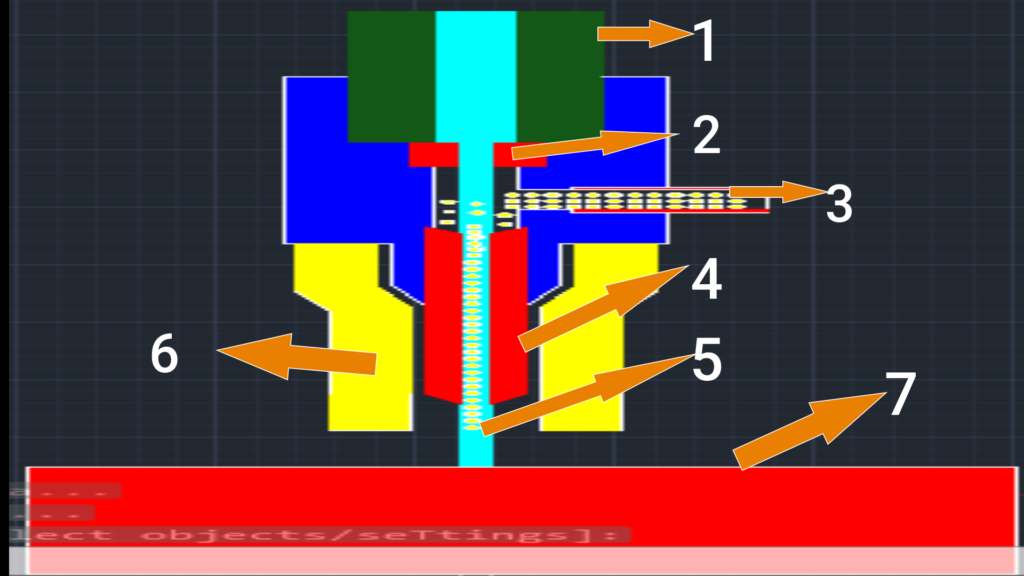What is water jet cutting?
A waterjet cutting is a non-conventional machining process that is used to cut softer materials and harder materials by using high-pressure waterjet.
A waterjet cutter is an industrial tool used to cut a wide variety of materials such as mild steel, stainless steel, rubber, aluminium and some other materials.
A waterjet cutter uses an extremely high pressure jet of water or sometimes a mixture of water and abrasive substance.
This waterjet cutting is mostly preferred for materials that are sensitive to high temperatures. Examples of such materials include plastic and aluminium.
Types of water jet cutting
There are two types of water jet cutting. They are
- Pure waterjet cutting or water only cutting
- Abrasive water jet cutting
Pure waterjet or water only cutting
A pure waterjet cutting or water only cutting is a type of cutting operation in which the cutting of materials is done by a high pressurized water jet without the use of abrasive substances.
This type of cutting is used to cut softer materials such as wood or rubber.
Abrasive water jet cutting
In abrasive water jet cutting, abrasive substance such as garnet sand is used to cut the harder materials such as metals.
Abrasives are materials known for their hardness. The abrasive materials are used in waterjet cutting to cut the harder materials such as metals and glasses.
Generally, an abrasive mixture consists of a proportion of 70 percent of water and 30 percent of abrasive.
The most widely used abrasive material in waterjet cutting is garnet. Garnet is a relatively hard mineral with its hardness ranging from 6.5 and 7.5 on the Mohs scale. They are mainly used for cutting operations.
Construction and working
The following diagram shows the components of a waterjet cutter.

1. High pressurized water inlet.
2. jewel
3. Abrasive (garnet sand).
4. Mixing tube.
5. Cutting waterjet.
6. Guard
7. Work piece (material to cut).
Components used in waterjet cutting
The following are the components used in waterjet cutting.
1. Water reservoir.
2. Pump.
3. Hydraulic intensifier.
4. Accumulator.
5. Direction control valve.
6. Mixing tube.
7. Nozzle.
8. Water bed
Water Reservoir
The water used for the waterjet cutting operation is stored in the water reservoir. The water reservoir or water tank requires some space to get mounted.
In many industries, the waterjet is placed at a certain height above ground level.
Pump
The pump transfers the water from the water reservoir to the hydraulic intensifier. The increases the water pressure up to 4 bar and then transfers it into the hydraulic intensifier.
Hydraulic intensifier
The hydraulic intensifier receives the water at 5 bar and increases its pressure to 3000 to 4000 bar. This hydraulic intensifier increases the pressure of the water required for water jet cutting.
Accumulator
The main purpose of the accumulator is to store this highly pressurized water temporarily. Then it transfers this high pressurized water to the direction control valve.
Direction control valve
This direction control valve transfers the high pressure water into the mixing chamber.
Mixing chamber
The mixing chamber mixes the highly pressurized water and the abrasive substance. The abrasive materials mostly used in the water jet cutting are garnet sand and aluminium oxide.
In the case of pure waterjet cutting (for softer materials such as rubber), no abrasive materials are used.
In the case of abrasive water jet cutting (for cutting harder materials), abrasive materials are used.
Nozzle
The main function of the nozzle is to convert the pressure energy of the water into high kinetic energy. when this high velocity of the water jet strikes the surface of the material, then cutting of the material takes place.
The tip of the nozzle is made of Ruby or diamond to prevent it from corrosion.
In waterjet cutting high pressurized water is forced through the nozzle to cut the material.
Drain and catcher system
The drain and catcher system is used to store the removed waste material and water and is recycled.
How to cut rubber using waterjet cutting?
Generally, rubber has a polymer called elastomer which enhances its elastic property.
Elasticity: The term elasticity is one of the mechanical properties in which the material retains its original position after the removal of load. Thus the material can be easily stretched from its original position.
Since rubbers are softer materials with high elastic properties, special techniques should be used before cutting them in the waterjet
During the waterjet cutting operation, the rubber may slip. This results in poor dimensional accuracy.
Hence these rubber are mounted on plywood and pinned using a screw. This prevents the slipping of rubber during the waterjet cutting operation.
Advantages of water jet cutting
- The water jet cutting is used to create complex cuts in materials.
- The machining area remains clean when compared to other machining processes
- It has low operating and maintenance cost.
- There is no heat generated in waterjet cutting. Hence thermal damage to the material is negligible.
- The water jet machining is used to cut softer materials such as rubber and also harder materials such as mild steel. other metals can also be machined by using the abrasive substance such as garnet sand and aluminium oxide.
- The water jet cutting is a non conventional machining process and also eco friendly as it does not create any pollutants or toxic products to the environment.
Disadvantages of water jet cutting
- Initial set up cost is ver high.
- Materials with very high thickness cannot be machined using waterjet cutting.
Applications of water jet cutting
The waterjet cutting is used in the automobile and aerospace industry for cutting composite materials.
The waterjet cutting can cut softer materials as well as the harder materials.
